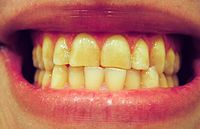
Photo from wikipedia
BACKGROUND During mastication, molars are subjected to heavy stress. However, a full explanation of the effects of physiological loads on tooth structures is lacking. OBJECTIVES The study aimed to determine… Click to show full abstract
BACKGROUND During mastication, molars are subjected to heavy stress. However, a full explanation of the effects of physiological loads on tooth structures is lacking. OBJECTIVES The study aimed to determine stress in molars and identify the mechanism of enamel damage in the grooves of the teeth during computer-simulated mastication. MATERIAL AND METHODS The study was carried out using the finite element method (FEM). A three-dimensional (3D) model of the first mandibular molar and of the crown of the opposing maxillary tooth was created. A food bite was introduced between the antagonistic teeth. The mastication cycle of the bolus was computer-simulated. The equivalent stress in the enamel and dentin of the mandibular molar was calculated according to the modified von Mises (mvM) criterion. RESULTS During the simulated chewing activity, the highest equivalent mvM stress and tensile stress concentrated on the molar enamel around the central groove and the foramen cecum. The value of the equivalent mvM stress was close to the tensile strength of the enamel. According to the mvM criterion, the enamel in these areas was exposed to destruction, which coincided with the occurrence of class I caries. CONCLUSIONS During mastication, significant tensile and mvM stress concentrates on the mandibular molar enamel around the central groove and the foramen cecum. High stress in these areas may cause prism microfractures and facilitate the bacterial penetration of the enamel.
Journal Title: Dental and medical problems
Year Published: 2023
Link to full text (if available)
Share on Social Media: Sign Up to like & get
recommendations!